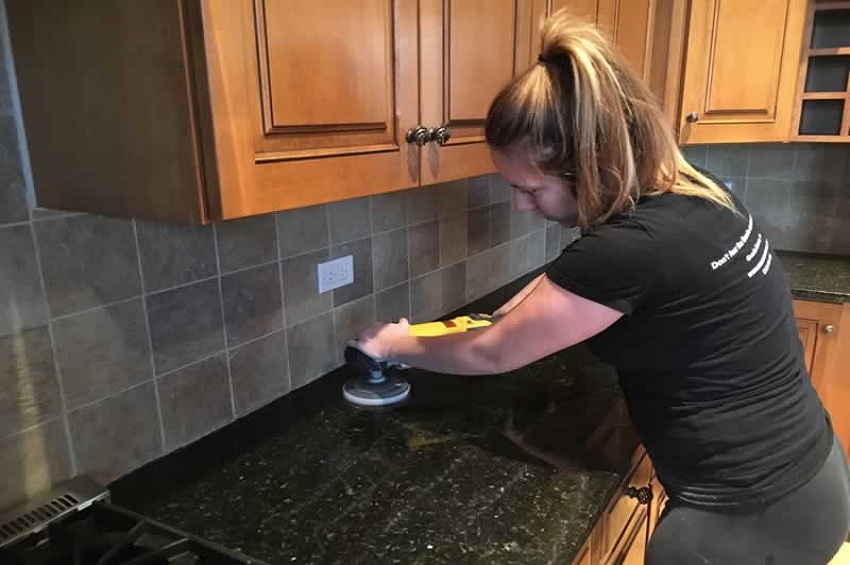What Is Stone Polishing, And Can You Do It Yourself?

More often than not, tumble polishing is used for vibratory polishing. For a tumbler to work, the rocks must have the same hardness. A barrel is filled with rocks, grit, and water and shaken. If the rock is hard, each step might take days to complete.
When it comes to stone countertops, they’re not always shiny. There are a plethora of ways to finish natural stone. Many different types of finishes may be achieved on natural stone surfaces with the proper tools. The topic of stone finishes is covered in this and other posts. Let’s go to work on that stone.
Which stones will polish?
Polishing is an option for many beach stones. Abrasive, almost-shiny stones polish the finest. Complicated as they are, grainy stones cannot be polished.
Stones may be tested for their hardness with a penknife. If the knife leaves a fine line or a mark on the stone, it will not polish. The stone will polish if the knife leaves a metallic mark. It is possible to polish serpentine with other stones of the same hardness, but only if they are of the same kind.
It takes less time to grind and polish softer stones. Thus their tumbling time is shorter. Many tiny stones may be used to polish one or two more giant stones.
Why Polish Stone?
Many stone owners prefer a polished surface. People are drawn to objects with a shiny finish because it symbolizes freshness and cleanliness. Only one of the many advantages of using polished stone is the way it looks and feels to the touch.
The longevity of the stone is further enhanced by using a polishing compound on the surface. How does a stone’s durability improve as a result of polishing? Compared with other treatments, polished stone is more resistant to stains.
A stone’s absorption capacity is reduced when it is polished. It is possible to polish stone in a variety of methods. Each of these methods reduces the absorption of stones. Depending on the stone and liquid, this may impact stain avoidance. Let’s have a look at some of the methods for polishing stone.
After stone polishing
As previously said, polishing stones may be done in various ways and using various methods. There are several methods for polishing stones, each performed at a particular moment in time and with a specific goal in mind.
A countertop may be polished in several ways if it is used for an extended period. It’s also probable that the various polishing methods will be used at different periods in time. Three of these will be the center of our attention.
Fabricators stone polish
Natural stone is first polished in a fabrication factory. After the slab has been carved, it is frequently polished to enhance its aesthetic appeal. Many of the tasks in fabrication workplaces may be automated thanks to the equipment on hand. Stone-edge-polishing wheels are used on these devices.
After they’ve been cut and shaped, stone countertops are polished by fabricators for use in a home or company. A slab’s edges and corners are likely to have this problem. Fabricators may also polish granite and marble when a freshly installed countertop or surface has to be retouched by the installers.
Restorative stone polishing
It is not uncommon for stone surfaces to be re-polished after many years of use. Natural stone may survive for decades with appropriate maintenance. The luster of a polished stone may fade over time. The luster of a kitchen counter may be tarnished by regular usage as well. A restorative polish may be performed or used by stone owners to restore or rejuvenate the shine of their stones. Whether or not a stone requires restorative polishing will be determined by the stone’s age and level of use. Depending on personal choice, this polishing may or may not be necessary.
Routinely polishing stone
Consistent polishing of the stone will ensure that the desired results are achieved. You don’t have to be a magician to keep a polished stone looking dazzling. This simple operation may be repeated regularly by the owner of the stone.
This method of polishing stone is efficient because it maintains the surface’s shine and polish by applying a small amount of luster at a time regularly. You may employ this method every week, every day, or every month.
If you’re asking yourself, “Is there a stone polisher near me?” you’ve come to the right place. Check out Cata Stone Care’s website for more information on where to find the best stone polisher.





